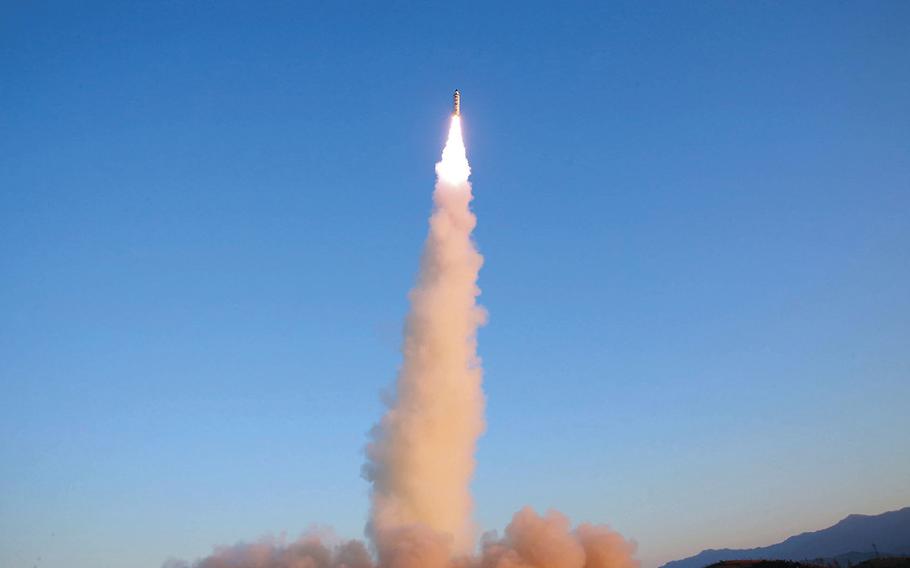
In this Sunday, Feb. 12, 2017, photo distributed on Monday, Feb. 13, 2017, by the North Korean government, "Pukguksong-2" is launched at an undisclosed location in North Korea. Independent journalists were not given access to cover the event depicted in this image distributed by the Korean Central News Agency via Korea News Service. The "Pukguksong-2" the North's Korean Central News Agency said was a "Korean style new type strategic weapon system." (Korean Central News Agency/Korea News Service)
SEOUL, South Korea – North Korea fired a missile that flew more than 310 miles before crashing into the sea Sunday, officials said, dealing what the Japanese prime minister called a “challenge to the world.”
The launch – the eighth missile test so far this year - came a week after the North fired a new missile that it said has the ability to carry a heavy nuclear weapon long distances.
White House officials traveling with President Donald Trump in Saudi Arabia said the missile launched Sunday had a shorter range than others tested recently.
The latest provocation dealt a new blow to efforts by the new U.S. and South Korean presidents to force the communist state to halt its nuclear weapons program.
Trump’s administration has vowed to seek tougher sanctions at the U.N. Security Council even as it has dangled the possibility of talks.
The medium-range missile was launched eastward from the vicinity of Pukchang, northeast of the capital Pyongyang, the U.S. Pacific Command said.
“The missile was tracked until it landed in the Sea of Japan,” command spokesman Cmdr. Dave Benham said in an email.
South Korea’s Joint Chiefs of Staff said the missile traveled more than 310 miles, but it stressed Washington and Seoul were still analyzing its type and trajectory.
The missile came as Trump was in Saudi Arabia as part of his first trip abroad since taking office on Jan. 20.
A South Korean military official told The Associated Press that the missile appeared to be similar in range and apogee to a solid-fuel missile fired by North Korea in February. The official, who spoke on condition of anonymity, said the missile fired Sunday reached a maximum altitude of about 350 miles.
Experts have said the North is making progress in developing a missile using a solid-fuel engine, which would allow the projectile to be fired more quickly than those that use liquid fuel.
North Korea has ratcheted up its testing program, conducing eight missile tests this year and some 30 since the current crisis erupted in January 2016.
It also carried out two underground nuclear tests last year, raising fears that it’s making swifter-than-expected progress toward its goal of developing a nuclear-tipped missile that could target the U.S. mainland.
The North celebrated the scientists and technicians behind last week’s test with a parade Thursday in Pyongyang, state-run media reported.
Experts said that was one of North Korea’s most successful tests yet and the missile would have the potential to reach Andersen Air Base on Guam if fired at a normal trajectory.
The United States and its allies have been frustrated by North Korea’s defiance in persisting with its weapons programs despite punishing sanctions and diplomatic pressure.
Sunday’s launch occurred just hours after South Korean President Moon Jae-in announced his new Cabinet picks. Moon convened a meeting of his National Security Council.
Moon took office earlier this month pledging a more moderate approach toward the North but he said last week that dialogue is only possible if the North “changes its behavior.”
Pyongyang insists its nuclear program is in self-defense, meant as a deterrent to what it believes is a threat of invasion by the U.S. and allied South Korea. It vowed to continue the program in a state-run media report on Saturday.
“The tightened pressure upon (North Korea) by the U.S. misleading the world public would only compel (North Korea) to bolster up its nuclear deterrent for justice,” the Korean Central News Agency reported.
Japanese Prime Minister Shinzo Abe, meanwhile, called the missile test a “challenge to the world,” saying the North’s repeated provocations “trample on the efforts by the international community toward a peaceful solution” to the standoff.
He also told reporters in Tokyo that he will bring up the issue as the “main agenda” at the G7 summit this week in Italy.
Twitter: @kimgamel